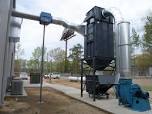Get In Touch
Get In Touch




A bottom dust collector, also known as a bottom filter or downflow dust collector, is an essential industrial air filtration system designed to capture and remove airborne particulates, dust, and contaminants from the environment. These units are typically installed beneath the work area, with polluted air being drawn downward into the collector. Utilizing a system of high-efficiency filters, they effectively trap and collect particulates, allowing clean air to be recirculated. Bottom dust collectors are widely used in various industries, including woodworking, metalworking, pharmaceuticals, and manufacturing processes, ensuring improved air quality, worker safety, and environmental compliance by mitigating airborne particle pollution.
1. Airflow Capacity: The airflow capacity is typically measured in cubic feet per minute (CFM) or cubic meters per hour (CMH) and represents the volume of air the dust collector can process.
2. Filtration System: Details about the type of filters used, whether they are bag filters, cartridge filters, or other filtration media. This should include the filter material (e.g., fabric, paper, synthetic), efficiency (e.g., HEPA, MERV rating), and the number of filter elements.
3. Filter Cleaning Mechanism: Information on the filter cleaning method, which can be pulse jet cleaning, reverse air cleaning, shaker cleaning, or other techniques used to remove accumulated dust from the filters.
4. Motor Power: The power rating of the motor driving the fan or blower, typically measured in horsepower (HP) or kilowatts (kW).
5. Fan/Blower Type: Details on the type and design of the fan or blower, including whether it's a centrifugal fan, axial fan, or other configuration.
6. Dust Collection Capacity: The maximum dust or particulate holding capacity of the collector, often specified in cubic feet or liters.
7. Pressure Drop: The pressure drop across the collector, indicating the resistance to airflow when filters are in operation, typically measured in inches of water column (inH2O).
8. Inlet and Outlet Size: The diameter of the inlet and outlet ports, which determines the size of ductwork that can be connected to the collector.
9. Dust Disposal Method: Explanation of how dust and collected particles are disposed of, which could involve a dust bin, hopper, or conveyor system.
10. Control System: Details on the control system, whether it's manual, automatic, or computerized, and any additional features like timers, differential pressure sensors, or remote monitoring capabilities.
11. Material of Construction: Information on the materials used in the construction of the dust collector, including the frame, housing, and filter materials, especially for corrosive or abrasive environments.
12. Noise Level: The noise level produced by the collector, typically measured in decibels (dB), which is crucial for maintaining a safe and comfortable working environment.
13. Certifications: Compliance with industry-specific standards, safety regulations, and certifications, such as ATEX for explosive atmospheres or OSHA requirements.
1. Metal Fabrication: Bottom dust collectors are utilized in metalworking shops to capture metal dust, fumes, and particulates produced during cutting, welding, and grinding processes, ensuring clean air and worker safety.
2. Woodworking: In woodworking facilities, these collectors manage wood dust generated by saws, sanders, and planers, improving air quality and reducing fire hazards.
3. Textile Industry: Dust collectors control the lint and fibers produced during textile manufacturing, including processes such as weaving and spinning.
4. Pharmaceutical Manufacturing: These collectors capture and remove dust and powders generated during pharmaceutical production, ensuring product quality and employee health.
5. Food Processing: In food and beverage processing, they manage flour, sugar, spices, and other food-related dust, maintaining hygiene and product quality.
6. Chemical and Petrochemical Plants: Bottom dust collectors handle hazardous chemical dust and particulates in chemical manufacturing and storage facilities.
7. Mining and Mineral Processing: They capture dust and particulates created during mining, crushing, and material handling operations.
8. Foundries: Dust collectors are used to control metal dust and fumes in foundry operations, including metal casting and molding.
9. Cement and Construction: They manage dust generated during cement and concrete production and construction material handling.
10. Automotive Industry: In auto manufacturing, these collectors capture dust and particulates produced during painting, welding, and grinding processes.
11. Electronics and Semiconductor Manufacturing: Dust collectors maintain the cleanliness of production environments by capturing dust and particles that can impact sensitive electronic components.
12. Aerospace Industry: They control dust and contaminants produced during the production of aerospace components, ensuring product quality and worker safety.
13. Chemical Laboratories: In research and testing labs, these collectors capture and remove hazardous chemical dust and particles.
14. Rubber and Plastic Manufacturing: Bottom dust collectors manage dust and particulates generated during the processing of rubber and plastic materials, including extrusion and molding.
15. Printing and Paper Industry: They capture paper dust and ink particles created during printing and paper manufacturing processes.
16. Waste Management and Recycling: Dust collectors are used in recycling facilities, waste transfer stations, and incineration plants to control dust generated during waste handling and processing.


